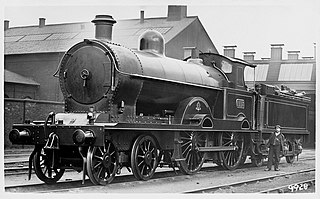LNWR Whale Precursor Class
The London and North Western Railway (LNWR) "Precursor" Class was a type of 4-4-0 ("American") steam locomotive designed by the company's Chief Mechanical Engineer, George Whale.
[1][2] Introduced in 1904, it should not be confused with the LNWR 2-4-0 "Precursor" Class of 1874 designed by Francis Webb, the last example of which was scrapped in 1895.
[5] 130 examples of the class were constructed at Crewe Works between March 1904 and August 1907,[6] their introduction allowing Whale to phase out the unreliable compound locomotives favoured by his predecessor, Francis Webb.
[12] However, having apparently experienced difficulty keeping time on trials between Crewe and Carlisle, they were not used on heavier gradients such as the climb to Shap.
[14] Nevertheless, double heading was still necessary on many trains north of Preston due to accelerated schedules and increased loads.
[3][17] A single example, 25297 "Sirocco", was inherited by British Railways in 1948, but this was withdrawn in June 1949 before the number it had been allocated (58010) could be applied.
On 17 June 1932, locomotive number 5278 Precursor was hauling the 7:23 p.m. Crewe to Stafford and Birmingham New Street express passenger service when, at around 7:52 p.m., the engine and all four coaches derailed just to the south of Great Bridgeford station, Staffordshire.
Together with the driver and fireman, 9 passengers received injuries serious enough to require hospital care, whilst a further 18 were treated at the scene and able to continue their journeys.
